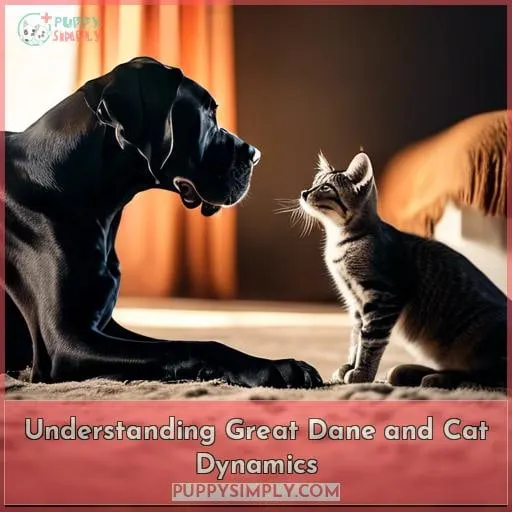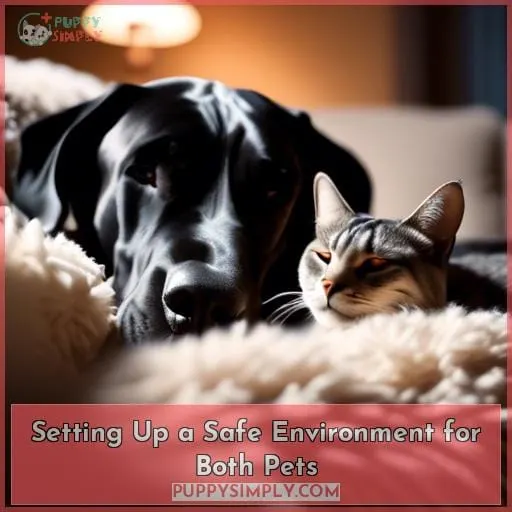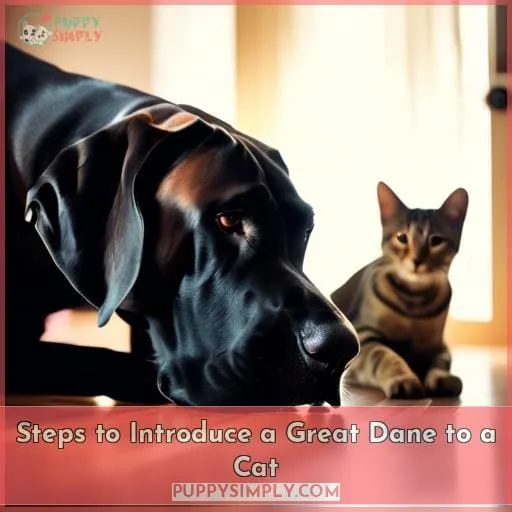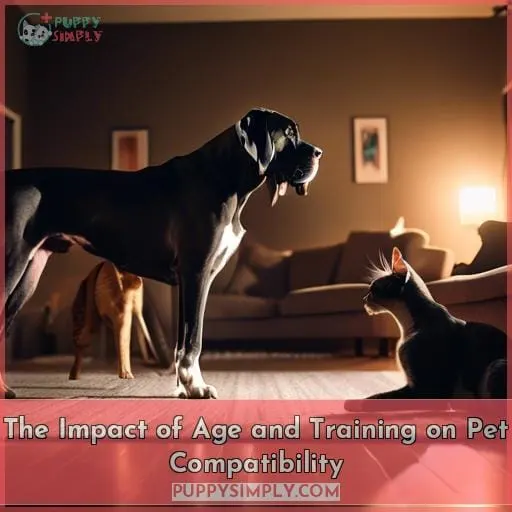This site is supported by our readers. We may earn a commission, at no cost to you, if you purchase through links.
 A house divided against itself cannot stand.
A house divided against itself cannot stand.
Don’t let your house become divided due to pet conflict!
Great Danes, known for their gentle nature, can coexist peacefully with cats.
Understanding their dynamics, setting up a safe environment, introducing them properly, and providing training can foster harmony.
Learn the surprising facts about these gentle giants and discover how to create a happy, united home for both your Great Dane and cat.
Table Of Contents
- Key Takeaways
- Understanding Great Dane and Cat Dynamics
- Setting Up a Safe Environment for Both Pets
- Steps to Introduce a Great Dane to a Cat
- The Impact of Age and Training on Pet Compatibility
- Great Danes and Other Pets: a Compatibility Overview
- Exploring Other Cat-Friendly Dog Breeds
- Frequently Asked Questions (FAQs)
- How do I know if my Great Dane is showing signs of aggression or discomfort towards my cat?
- Can Great Danes live in an apartment with cats, or do they need a specific living space?
- How do I teach my Great Dane to respect the cat’s personal space and boundaries?
- Are there any specific breeds of cats that are more compatible with Great Danes than others?
- Conclusion
Key Takeaways
- Great Danes are typically gentle and calm, but their large size can make interactions with cats challenging.
- Creating a safe environment with pet gates, high spaces for the cat, and close supervision is essential for a harmonious relationship.
- Introduce the Great Dane and cat gradually, manage anxiety, and use positive reinforcement to promote positive interactions.
- Early socialization, obedience training, and selecting a dog with a friendly personality can improve compatibility between the two pets.
Understanding Great Dane and Cat Dynamics
As you contemplate the dynamics between Great Danes and cats, you must acknowledge the following:
- The Dane’s generally gentle nature.
- The cat’s need for ample personal space.
- How the sheer size difference between the two species can impact their interactions.
Recognizing Great Dane’s Gentle Nature
Although Great Danes are known for their large size, you’ll be surprised to learn they often possess a gentle and amiable temperament.
This inherent gentleness makes them suitable companions for cats, fostering a harmonious household.
Their calm demeanor and patient nature contribute to their compatibility with felines, creating a peaceful coexistence between these seemingly disparate species.
Acknowledging the Cat’s Need for Space
Considering the Great Dane’s colossal size, you must recognize the cat’s need for personal space.
Respecting this boundary is crucial for fostering harmony.
Provide high spots and secluded nooks where the cat can retreat when overwhelmed.
Ensuring comfort and a sense of sanctuary helps build trust and promotes a peaceful coexistence.
The Role of Size in Pet Interactions
You’ll need to be mindful of the size difference between your Great Dane and your cat, as it can impact their interactions.
The sheer size of a Great Dane can be intimidating to a cat, potentially leading to fear or avoidance.
Conversely, a Great Dane’s gentle nature and lack of predatory instincts make them generally safe around cats.
Understanding the size dynamics and potential impact on behavior is crucial for successful cohabitation.
Setting Up a Safe Environment for Both Pets
To safeguard the cat from the Great Dane’s size and potential curiosity:
- Create high spaces for the cat’s escape.
- Install pet gates to prevent conflict.
- Observe the cat’s behavior for signs of discomfort.
Importance of High Spaces for Cats
Provide high spaces for your cat to escape to when overwhelmed by the Great Dane’s size.
Vertical retreats offer a sense of security and control.
Feline perching instincts allow cats to survey their surroundings.
Elevated havens become cozy resting spots away from canine chaos.
Cat trees provide essential climbing and scratching outlets.
Using Pet Gates to Prevent Conflict
To prevent conflict and promote a safe environment, you can install pet gates between rooms to separate the dog and cat when you’re not around to supervise.
This creates boundaries and gives your cat a safe space to retreat when needed.
Pet gates also help manage space and prevent interactions that could lead to conflict or stress for either animal.
By using pet gates, you can help ensure a peaceful coexistence between your Great Dane and cat.
Recognizing Signs of Discomfort in Cats
Observe your cat’s behavior for signs of discomfort, like hissing or dilated pupils, to keep the peace.
Understand their body language to prevent escalation.
Recognize when your Great Dane’s curiosity or playfulness overwhelms the cat, leading to stress signals.
Managing these interactions ensures a harmonious household where both pets feel safe and respected.
Steps to Introduce a Great Dane to a Cat
When introducing your Great Dane to your cat, start by ensuring a safe environment with escape routes for the cat.
Then, control direct contact by holding the cat while the dog sniffs it.
Finally, gradually increase their interactions under close supervision.
Preparing for the First Encounter
Before their first face-to-face meeting:
- Walk your Great Dane for 30 minutes to calm their energy levels.
Initiate the initial interaction:
- Hold the cat in the air, preventing direct contact.
- Gradually introduce them on the floor or sofa, allowing them to sniff each other while you supervise.
Establish boundaries:
- Provide the cat with high spaces to escape and retreat.
Manage anxiety:
- Stay calm and composed during their interactions.
- Build trust over time.
Managing Direct Contact Between Pets
Once your Great Dane’s calmness is ensured, hold the cat in the air, preventing direct contact.
This supervised interaction allows them to become accustomed to each other’s presence and scent.
Employ training techniques to teach your dog to respect the cat’s boundaries.
Positive reinforcement and behavior modification can help create a harmonious relationship.
Monitoring and Supervising Interactions
While introducing your Great Dane and cat, supervise closely.
Ensure both pets remain calm and comfortable during their interactions.
Monitor their body language and behavior, intervening if signs of stress or aggression arise.
Implement safety measures like leashes or barriers to prevent sudden movements or attacks.
Observe their interactions, noting positive and negative behaviors, and adjust your supervision techniques accordingly.
By monitoring and supervising their interactions, you can help prevent conflict and foster a harmonious relationship between your Great Dane and cat.
The Impact of Age and Training on Pet Compatibility
Early socialization for both dogs and cats promotes a peaceful relationship.
Obedience training for the dog improves its ability to behave calmly around the cat.
Selecting a dog with a friendly personality can enhance their compatibility.
Benefits of Early Socialization
Socializing your pets from a young age can make them more adaptable to other animals, leading to harmonious relationships.
Early socialization exposes pets to diverse experiences, shaping their behavior patterns and social development. This environmental influence helps them understand appropriate interactions with other species, reducing fear and aggression.
Moreover, early training reinforces positive behaviors, promoting obedience and cooperation, which are crucial for a peaceful multi-pet household.
Role of Obedience Training in Pet Harmony
You’ll also want to take obedience training seriously, as it can significantly contribute to a harmonious relationship between your dog and cat.
Advanced techniques:
- Positive reinforcement and behavioral cues can effectively modify your dog’s behavior.
Training methods:
- Consistency and patience are key to successful training.
Emotional connection:
- A well-trained dog is more likely to respect your cat’s boundaries and respond calmly to its presence.
Behavioral cues:
- Teach your dog basic commands like sit, stay, and come to control their behavior around the cat.
Mutual understanding:
- Training fosters mutual understanding and respect between your pets, leading to a peaceful coexistence.
Selecting a Dog With a Friendly Personality
Selecting a Great Dane with a friendly personality is just as important as obedience training in creating a harmonious relationship between your dog and cat.
Consider these key factors:
| Personality Traits | Benefits |
|---|---|
| Gentle and Calm | Less likely to startle or chase the cat |
| Playful and Energetic | Can engage in controlled play with the cat |
| Curious and Inquisitive | More likely to accept the cat’s presence |
Early socialization and obedience training can enhance these positive traits, promoting a peaceful coexistence between your Great Dane and cat.
Great Danes and Other Pets: a Compatibility Overview
Great Danes can coexist with other pets, but precautions are needed to ensure their safety.
Some breeds, like Golden Retrievers and Beagles, tend to get along well with cats, while others may require more training and supervision.
The size difference between Great Danes and cats can also pose challenges, so creating safe spaces for both animals is essential.
Great Danes and Their Interaction With Other Animals
A Great Dane’s gentle nature often extends to other animals, including cats, making them great companions for multi-pet households.
Their size, however, necessitates caution, as playful interactions can inadvertently harm smaller animals.
Providing safe havens for both pets and implementing training techniques that emphasize gentle behavior can mitigate these risks.
Socialization from an early age is key to fostering harmony between Great Danes and other pets.
Exposing them to various animals in controlled environments helps them develop positive associations and reduces the likelihood of aggressive behavior.
Choosing breeds known for their compatibility with cats, such as Golden Retrievers or Beagles, can further enhance the chances of a peaceful coexistence.
Precautions to Ensure Safety
To ensure the safety of your pets, you’ll need to take precautions when introducing a Great Dane to other animals:
- Provide safe retreats, like high spaces for cats to escape if overwhelmed.
- Supervise pet interactions closely, especially initially.
- Early socialization is key; expose your Great Dane to other animals from puppyhood.
- Consider the size dynamics; a Great Dane’s sheer size can be intimidating to smaller pets.
- Obedience training is crucial; teach your Great Dane basic commands to control their behavior around other animals.
Exploring Other Cat-Friendly Dog Breeds
In addition to Great Danes, various other dog breeds are known for their compatibility with cats.
Golden Retrievers, Maltese, Beagles, Pugs, English and French Bulldogs, Spaniels, Papillons, and Bichon Frises are just a few examples of breeds that often display gentle and tolerant behavior towards felines.
These breeds possess unique temperaments and characteristics that make them suitable companions for cats in various households.
Golden Retrievers and Cats
Golden Retrievers’ playful nature and gentle temperament make them wonderful companions for cats.
This fosters harmony in your multi-pet household.
Maltese and Cats
With their chill vibes,
Maltese often ignore cats,
Offering cozy companionship
Without overwhelming presence.
Beagles and Cats
Beagles, too, see feline friends as pack members, fostering cautious connections.
Supervise their furry friendships to ensure safe spaces for both canine and feline comrades.
Pugs and Cats
Next, let’s explore the delightful dynamic between Pugs and cats:
- Playful cuddlers
- Cozy nappers
- Cautious companions
English and French Bulldogs and Cats
Bulldogs and cats cuddle, nap, and play.
Caution: larger Bulldogs may overwhelm cats.
Spaniels and Cats
- Spaniels’ patience and loving nature make them feline companions, handling scratches gracefully.
Papillon and Cats
Playful Papillons with butterfly ears adore feline friends.
Their curiosity sparks cat bonds, while their small size ensures harmonious pet playdates.
Bichon Frise and Cats
Bichon Frises’ small, fluffy stature makes them safe playmates for cats, fostering playful companionship.
Size Considerations:
- Smaller size ensures safer interactions.
Socialization Benefits:
- Early socialization promotes harmony.
Fluffy Buddies:
- Mutual acceptance and playful bonding.
Frequently Asked Questions (FAQs)
How do I know if my Great Dane is showing signs of aggression or discomfort towards my cat?
Watch for signs of stress in your Great Dane, such as:
- Dilated pupils
- Flattened ears
- A stiff tail
Observe interactions closely, and if you notice any of the following, separate the animals immediately:
- Growling
- Lunging
- Snapping
Can Great Danes live in an apartment with cats, or do they need a specific living space?
Great Danes in apartments with cats thrive like surfers catching waves,
adapting to the ebb and flow of feline antics with grace and patience.
How do I teach my Great Dane to respect the cat’s personal space and boundaries?
With patience and training, you can teach your Great Dane to respect your cat’s boundaries.
Start by keeping them separated.
Gradually introduce them in controlled environments.
Positive reinforcement and consistent training will help foster a harmonious relationship.
Are there any specific breeds of cats that are more compatible with Great Danes than others?
Cat breed selection can influence compatibility with Great Danes.
Consider breeds known for their adaptability, friendliness, and tolerance, such as:
- Ragdolls
- Maine Coons
- Siamese
Conclusion
Witness the awe-inspiring spectacle of a Great Dane and a cat coexisting in harmony, dispelling the myth of an inherently divided household.
With careful planning, a peaceful oasis can be cultivated, where the gentle giant and the feline enigma coexist in tranquility.
Great Danes and cats, united by a common bond, demonstrate the extraordinary power of understanding and respect, proving that even the most disparate creatures can find solace in each other’s company.












